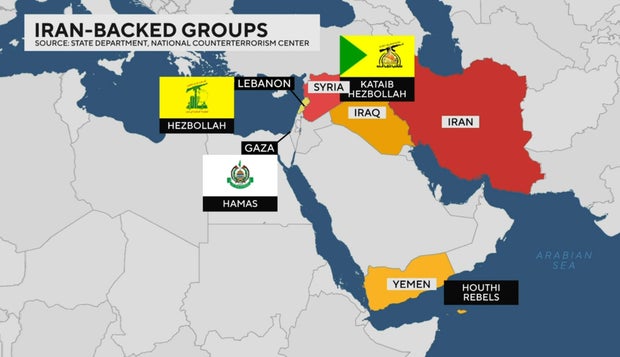World
Israel launches deadly strikes on Hezbollah in Lebanon, warns people in Beirut and elsewhere to evacuate

Missiles slammed into southern Lebanon, shattering the early-morning silence Monday and reportedly killing more than 490 people as Israel said it was targeting Hezbollah weapons hidden in residential buildings. The explosions came as Israel heralded a new wave of attacks on the Iran-backed group in Lebanon, warning civilians to flee from any buildings or areas where the organization had weapons or fighters positioned.
Lebanon’s health ministry said the strikes killed 492 people, including 35 children and 58 women, and wounded 1,645 people, The Associated Press reported. Monday marked the deadliest day of fighting between Israel and Hezbollah since 2006. The death toll also surpassed the deaths from the 2020 explosion at the Port of Beirut that killed nearly 200 people, injured thousands and devastated entire neighborhoods in the Lebanese capital.
Israel’s military said at least 35 more rockets or drones were fired from Lebanon at northern Israel, many of which fell in open areas or were intercepted. Israeli media said at least one man was injured amid the barrage.
Aziz Taher/REUTERS
The new crossfire came as Israel warned people in Lebanon — via automated phone calls, text messages and reportedly even Lebanese radio stations hacked into by its military — to avoid buildings used by Hezbollah.
The IDF shared images online of what it said were secondary explosions following some of its strikes Monday in southern Lebanon, showing, it said, “Hezbollah’s weapons exploding inside homes.”
“Every house that we strike contains weapons — rockets, missiles, UAVs — that are intended to kill Israeli civilians,” the IDF said. It said 300 separate Hezbollah targets were hit in its Monday morning airstrikes in Lebanon.
President Joe Biden said on Monday that the U.S. was trying to calm the situation in Lebanon.
“I’ve been briefed on the latest developments in Israel and Lebanon. My team is in constant contact with their counterparts, and we’re working to de-escalate in a way that allows people to return home safely,” Mr. Biden said as he held talks with UAE President Sheikh Mohamed bin Zayed Al Nahyan at the White House.
Meanwhile, the Pentagon said Monday the U.S. is sending additional troops to the Middle East. Pentagon press secretary Maj. Gen. Pat Ryder would provide no details on how many additional forces or what they would be tasked to do. The U.S. currently has about 40,000 troops in the region.
The new violence came after a weekend of increasingly deadly crossfire between the two bitter enemies in the heart of the Middle East.
Hezbollah launched more than 100 rockets in one salvo Saturday night, sending them hurtling deeper into northern Israel and “toward civilian areas,” according to the Israeli military, wounding at least three people and spreading panic further into a region where many towns and villages have already been abandoned.
In a video posted on social media, Israel Defense Forces spokesperson Avichay Adraee said Monday morning that raids on homes and other buildings being used by Hezbollah to hide and launch weapons in Lebanon would “begin soon,” warning residents to follow orders from the Israeli army to evacuate.
“The raids will begin soon. Evacuate the houses where #Hezbollah has hidden weapons immediately,” Adraee said in the video, speaking Arabic. “Hezbollah is lying to you and sacrificing you.”
“We are deepening our attacks in Lebanon, the actions will continue until we achieve our goal to return the northern residents safely to their homes,” Israeli Defense Minister Yoav Galant said in his own video message, warning his nation of “days ahead of us when the public will have to show composure.”
The warning to Israelis was likely a reference to expected retaliation from Hezbollah or Iran’s other so-called proxy groups in the region.
CBS News
Lebanon’s state-run media said people in some parts of the capital Beirut and in southern areas of the country — both areas where Hezbollah has long enjoyed significant support — received automated phone messages warning them to evacuate. The French news agency AFP said someone in national Information Minister Ziad Makary’s office got one of the calls.
The minister’s office told AFP that someone took a call on the office landline and heard a “recorded message” telling them to evacuate.
The warnings about what appeared likely to be a significant intensification of Israel’s assault on Hezbollah came after a weekend of increased fire between the two sides over Israel’s northern border with Lebanon, where the Iranian-backed group is a powerful political and military force.
Hezbollah started launching rocket and drone attacks on Israel as soon as Israel launched its war on Hamas in the Gaza Strip in response to that group’s Oct. 7 terrorist attack. Both Hezbollah and Hamas are backed by Israel’s long-time arch rival Iran, and both have long been designated as terrorist groups by both the Israeli and U.S. governments.
The IDF has stepped up strikes on purported Hezbollah targets across Lebanon for weeks, vowing to remove the threat they pose to enable the safe return of tens of thousands of residents from towns and villages in Israel’s northern border region who’ve been evacuated due to the cross-border fire.
As Israel ramps up offensive operations against Hezbollah, it does so with wary U.S. support. The Biden administration has voiced concern for months about the tit-for-tat attacks by Israel and Hezbollah, simmering in parallel to the war in Gaza, escalating into a full-scale conflict. The concern is based largely on an assessment that a wider conflict in the Middle East will put U.S. troops increasingly in direct danger. Iran-backed militias in Iraq and Syria have already targeted U.S. forces in the region with deadly drone fire during the Gaza war.
U.S. Secretary of Defense Lloyd Austin spoke on Saturday and Sunday with Gallant amid the increasing hostilities, and he “reaffirmed the United States’ commitment to Israel’s right to defend itself,” according to a readout of the first call from the Pentagon, but he also “stressed the importance of achieving a diplomatic solution” to the crisis and “his concern for the safety and security of U.S. citizens in the region.”
According to the readout of the Sunday night phone call, Austin “made clear that the United States remains postured to protect U.S. forces and personnel and determined to deter any regional actors from exploiting the situation or expanding the conflict.”
The long-feared escalation in violence between Israel and Hezbollah — which is a far larger and far better equipped militant group than its ally Hamas — started snowballing last week with Israel’s officially-unclaimed covert operations to blow up thousands of pagers and walkie talkies carried by Hezbollah members in Lebanon. Those attacks killed about 40 people, including an unconfirmed number of Hezbollah figures and at least two children, according to Lebanese officials.
Hezbollah leader Hassan Nasrallah admitted the explosions were a “severe blow” to the group, and he accused Israel of not only violating “all red lines” with the attacks, but of a “declaration of war.”
Israel hasn’t admitted to carrying out the complex attacks using rigged communications device, but CBS News learned that American officials were given a heads-up by Israel about 20 minutes before the operations began, though no specific details were shared about the methods to be used.
The Associated Press contributed to this report.












